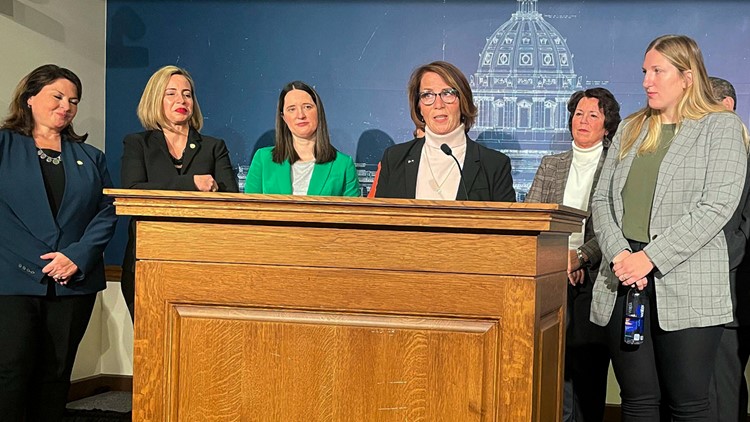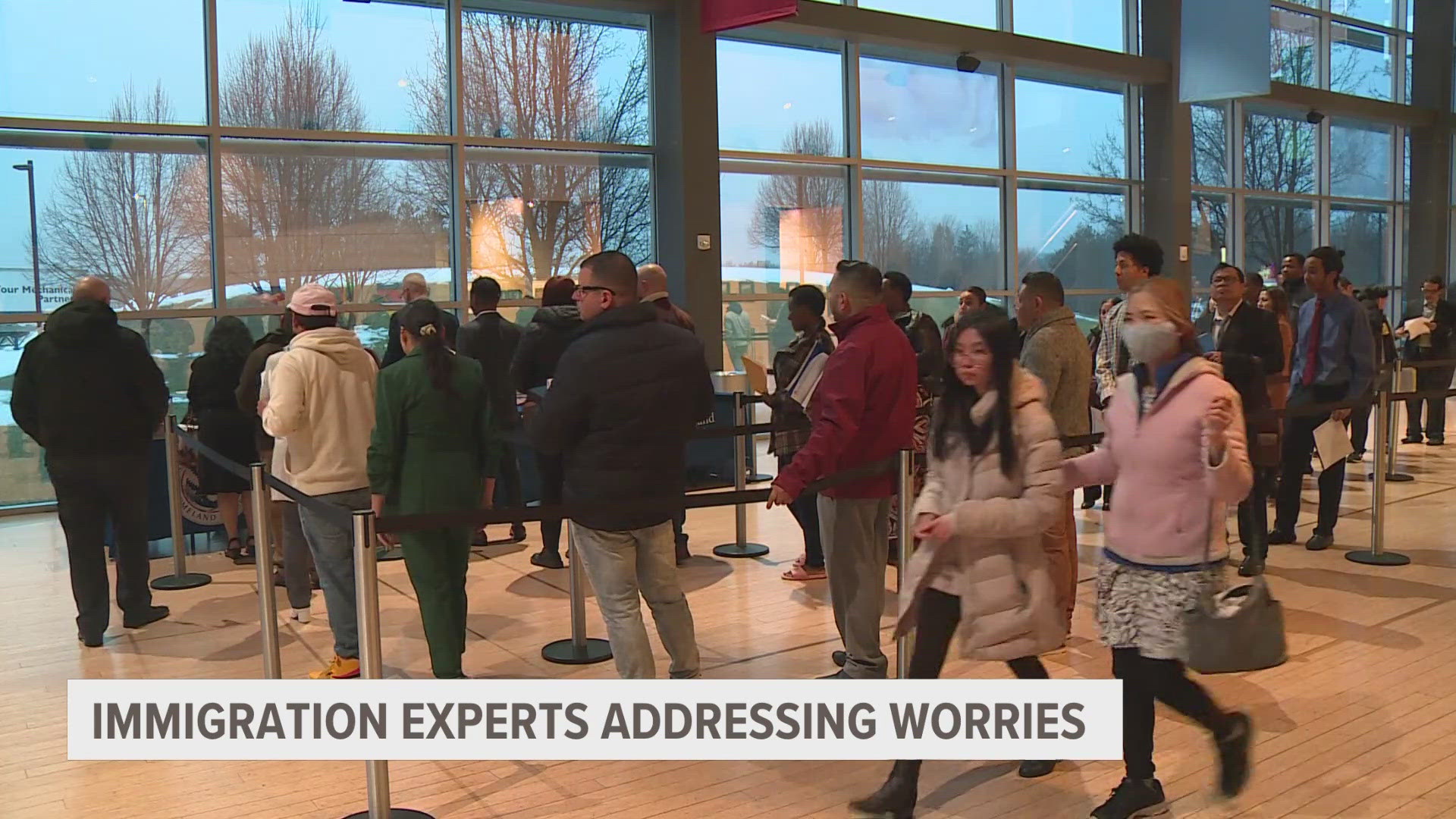MICHIGAN, USA — Bucking historic midterm election trends, Democrats wrested control of state legislative chambers away from Republicans in Michigan and Minnesota while also gaining full control of state capitols in Maryland and Massachusetts.
The Democrats' gains in Tuesday's elections gave them power to set the agenda on topics ranging from state taxes and spending to contentious social issues in four states that previously had politically divided governments.
Democrats also gained legislative seats in Pennsylvania, another important presidential swing state where Republican lawmakers have held majorities against a Democratic governor.
Future control of several legislatures — including Republican-led Arizona's and Democratic-led Nevada's — remained unclear Wednesday as votes were still being counted. The New Hampshire House clerk said results show an almost even partisan divide in the 400-member chamber. That could set the stage for either unprecedented bipartisanship or major gridlock.
Democrats were thrilled with the results so far, especially since the president's party almost always suffers legislative losses during midterm elections.
"By all accounts, this election should have been a landslide for Republicans. Instead, their so-called red wave is looking more like a puddle,” said Jessica Post, president of the national Democratic Legislative Campaign Committee.
Republicans entered the election with full control of both legislative chambers and the governor's office in 23 states, compared to 14 for Democrats, with the rest divided.
Democrats already controlled both legislative chambers in Maryland and Massachusetts but picked up their governorships by capturing seats being vacated by Republicans.
Even with Democratic gains, Republicans still will control more states and more total legislative seats.
Only twice since 1900 had the president's party posted a net increase in state legislative seats during a midterm election — in 1934 during the Great Depression and in 2002, a year after the Sept. 11 terrorist attacks, according to the National Conference of State Legislatures.
This year, “it’s becoming apparent that if either side gains seats, it’s going to be a narrow margin relative to history," said Ben Williams, the NCSL's principal for elections and redistricting.
Republicans said going into the election that they would be happy to keep what they held, though they had targeted several states for potential gains.
Despite some losses, Republicans withstood bigger Democratic spending in some states and "an incredibly challenging political environment” to maintain a majority of state legislatures, said Andrew Romeo, communications director for the Republican State Leadership Committee.
A summertime U.S. Supreme Court's decision ending a half-century of national abortion rights — and returning the issue to states — gave Democrats a new campaign theme to counter Republican ads blaming Democrats for rising inflation and economic concerns.
In Michigan, voters passed a state constitutional amendment guaranteeing abortion rights while narrowly electing Democratic legislative majorities. Lawmakers were running for the first time in new districts drawn by an independent citizens committee that gave Democrats a better chance than the previous districts draw by the GOP-led Legislature.
When newly elected lawmakers take office along with Democratic Gov. Gretchen Whitmer, it will mark the first time in 40 years that Democrats wield full control of Michigan government.
State Sen. Jeremy Moss, campaign co-chair for Michigan's Senate Democrats, said voters would see a different policy focus.
“We really have to restore the dignity of Michigan’s middle and working class," Moss said. “That includes uplifting labor rights. That includes reversing this tax shift that Republicans placed upon them. That includes pushing forward on equal protection under the law.”
Though the economy was the top issue for Michigan voters, a majority also said the abortion ballot initiative was very important and that their views aligned most closely with the idea that abortion should be legal in all or most cases, according to AP VoteCast, an expansive survey of more than 3,200 of the state’s voters.
Republican House Speaker Jason Wentworth attributed the loss to redistricting and “special interests from all over the country” that aided Democrats. He predicted that Republicans would regain the chamber in two years.
In Minnesota, Democrats won control of the state Senate from Republicans while also defending their House majority against a Republican takeover attempt. Democratic Gov. Tim Walz also won reelection.
Democratic lawmakers said Wednesday that their agenda could include codifying abortion rights, legalizing recreational marijuana and increasing education funding, among other things.
Amy Koch, a former Republican Minnesota Senate majority leader turned political strategist, said the GOP should have won Tuesday. But she said Republicans failed to appeal to women who opposed the Supreme Court's abortion ruling and "were just upset with the GOP brand.”
"If Republicans don’t address that, we are never going to win statewide,” Koch said.
Republicans controlled both of Pennsylvania's legislative chambers heading into the election. But Democrats made significant gains in the House, with some Democrats even predicting the chamber could flip their way by the time all the votes are counted.
The political shift was aided by more favorable districts drawn by four top lawmakers and a tie-breaking outsider, a slew of Republican retirements and victories by Democrats in high-profile races for governor and U.S. Senate.
By contrast, Ohio Republicans expanded their legislative majority while running under new districts drawn by a Republican-controlled redistricting commission. The maps remained in place for this election even though the state Supreme Court said they are unconstitutional and must be redrawn in the future.
Republicans won 26 of the 33 Ohio Senate seats — the largest supermajority since 1951, according to Ohio Senate President Matt Huffman.
Republicans also made gains in South Carolina, winning more than two-thirds of the House seats for the first time since at least Reconstruction.
But Republicans were short in their quest for veto-proof majorities in both legislative chambers in North Carolina and Wisconsin — two states with Democratic governors.
Alaska was among the states where legislative control might not be determined for a while.
Under the state's new ranked choice voting system, if no one wins more than 50% of first-choice votes in a race, the next-choice votes for eliminated candidates will be tabulated in a process that's expected to occur Nov. 23. But even that might not determine legislative control, because Alaska lawmakers don’t always organize along party lines. After the last two general elections, it took weeks into the next legislative session before the House formed a leadership coalition.
___
Lieb reported from Jefferson City, Mo., Associated Press writers Becky Bohrer in Juneau, Alaska; Joey Cappelletti in Lansing, Mich.; Jeffrey Collins in Columbia, S.C.; Samantha Hendrickson in Columbus, Ohio; Steve Karnowski in Minneapolis; Holly Ramer in Concord, N.H., and Mark Scolforo in Harrisburg, Pa., contributed to this report.
___
Follow the AP’s coverage of the midterm elections at https://apnews.com/hub/2022-midterm-elections and check out https://apnews.com/hub/explaining-the-elections to learn more about the issues and factors at play.
►Make it easy to keep up to date with more stories like this. Download the 13 ON YOUR SIDE app now.
Have a news tip? Email news@13onyourside.com, visit our Facebook page or Twitter. Subscribe to our YouTube channel.



